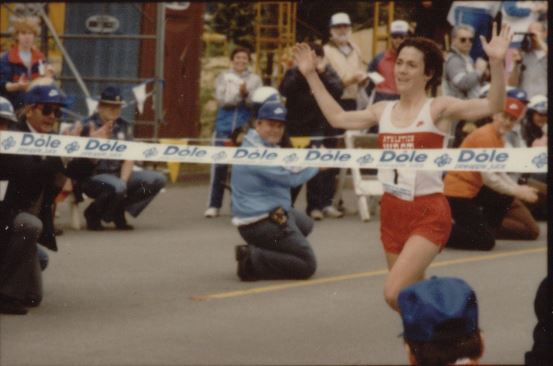
By Eric Wilson-Edge
 History never really goes away. The landscape changes and people age but the soul of the experience stays. You’ve seen it as the woman running down the street, something so commonplace you’d think it was always accepted.
History never really goes away. The landscape changes and people age but the soul of the experience stays. You’ve seen it as the woman running down the street, something so commonplace you’d think it was always accepted.
On May 12, 1984, Olympia stepped onto the national stage. Thousands lined the streets to watch 238 women compete for the chance to be in the Olympics. In 1981 the International Olympics Committee formally recognized women’s marathon as an Olympic sport. Olympia hosted the trial.
But we’re getting ahead of ourselves. You don’t have to journey too far back to believe this moment would never happen. It was once believed that, “violent movements can cause a shift in the position and a loosening of the uterus.” This would leave a woman sterile and defeat her “true purpose in life.”
This belief held well into the 20th century. Katherine Switzer became famous for being the first woman to officially run the Boston Marathon. Roberta Gibb snuck in the year before but was not officially entered. You may have seen the images of the race organizer Jock Semple trying to rip Switzer’s number off mid-race. Switzer’s high school basketball coach – a woman – once told her, “excessive number of jump balls could displace the uterus.”

The cultural revolution of the 1960’s opened new doors for women. Title IX became law in 1972. In 1973, Billie Jean King beat Bobby Riggs in the famed “Battle of the Sexes.” Later that decade, cosmetics company Avon started a series of women-only marathons. These races brought women’s running to the forefront and proved a women’s marathon could be financially successful.
Jacqueline Hansen is a legend in the running world. Hansen won the Boston Marathon in 1973. She is also the first women to finish a marathon in under 2:40:00. Hansen, along with a small group of others, was instrumental in getting women’s marathon into the Olympics.
“I wasn’t seeking a cause,” says Hansen. “I saw something terribly wrong with our sport and thought I knew how to fix it.” Hansen and a small cadre of men and women formed the International Runners Committee. The IRC started letter writing campaigns and petitions. They hired a lobbyist to help get their message across.
Social change typically comes in baby steps, not leaps. Two years of writing, flying, debating and running paid off. The IOC accepted women’s marathon as an event in 1981. The race would happen. Now it needed runners.
Laurel James might be afraid of something, but taking chances isn’t one of them. In 1975, James opened one of the first running stores, Super Jock N’ Jill, in Seattle. “When I started Super Jock N’ Jill they told me it couldn’t be done because it hadn’t been done before.”
In 1981, organizers for the Capital City Marathon invited James to help design the course. During one of the meetings she pitched the idea of putting together a bid for the Olympic Trials. “Everyone in Olympia got onboard,” says James. “They were awesome.”
The pitch took place in 1982. Olympia went up against goliaths like New York and Los Angeles for the right to hold the trial. “They didn’t even know where we were from,” says James. “But there was no denying us.”
A group of eight people (four official) flew to Philadelphia for the presentation, including Gerry Alexander. “We couldn’t compete with LA and New York with skyscrapers so we featured the natural beauty of the Northwest.” In a sly move, the group also brought along smoked salmon, oysters, apple cotlets and cans of Olympia Beer.
Senator Slade Gordon gave the presentation. “We put together the most professional presentation that had been done in the history of the Athletic Congress,” says James. It worked. Olympia won the bid and would host the trial.
May 12, 1984 was an unusual day. The weather was decent, not too hot and no rain. 238 women lined up at the start line – one was a 54-year-old nun, another was pregnant. These women had all met the qualifying time of 02:51:16.
Jacqueline Hansen made it – on her last try. Hansen was 36 at the time and nursing an injured hamstring. She qualified at the Boston Marathon but she doesn’t remember. Hansen blacked out from hypothermia. “When I woke up the first thing I asked was ‘did I make it?’”
Olympia secured the trial on the strength of the community. Marathoner Julie McKinney remembers, “they guaranteed housing for every athlete who qualified and provided transportation.”
Indeed, Saint Martin’s University altered its schedule so dorms could be available to the runners. Volunteers made embroidered pillows for each participant, kids made signs for each athlete. Food was provided and every woman in the marathon had an official hugger. This person would stand at the finish line and provide hugs, blankets and anything else the runner needed.
ABC’s “Wide World of Sports” had been convinced to broadcast the event. Throngs of supporters showed up to witness history in the making. History started at exactly 9:23 a.m. near what is now the Red Lion Hotel.
The race ended at Marathon Park when Joan Benoit crossed the finish line with a time of 02:31:04. Benoit had knee surgery two weeks before the trial. She ended up winning the Olympic Gold medal in Los Angeles later that year.
Jacqueline Hansen didn’t win but it didn’t matter. Hansen had pneumonia at the time. “All that mattered to me was that I got my name on that start list and on the finish list.”
Julie McKinney ran in the 1988 trials in Pittsburgh. She took her son along. When asked if he wanted to participate in a kid’s race McKinney’s son said, “no mommy, only girls run.”
History never really goes away. The men and women who organized and participated in the 1984 Olympic Trials carried the flame for the next generation. Their spirit is in every footfall of every runner coming down the street.




















































